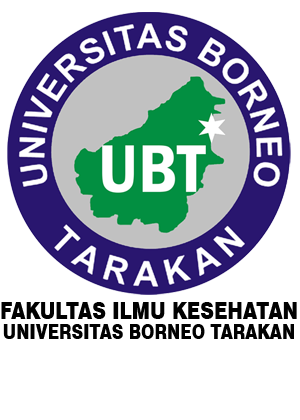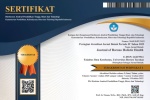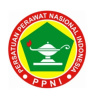Risiko Paparan COVID-19 pada Perawat di Ruang Isolasi
Abstract
Abstrak
Pendahulua: risiko dan bahaya penularan penyakit infeksi di tempat kerja bagi perawat mengalami peningkatan seiring dengan pertambahan jumlah dan intensitas interaksi dengan pasien. Tujuan penelitian: menilai risiko paparan COVID-19 pada perawat yang merawat pasien COVID-19 di ruang isolasi COVID-19. Metode penelitian: desain cross sectional dengan pendekatan observasional. Sampel penelitian berjumlah 50 orang responden yang ditentukan dengan metode total sampling  pada perawat yang bekerja di ruang isolasi COVID -19 di salah satu rumah sakit rujukan pasien COVID-19 di kota Makassar, Provinsi Sulawesi Selatan, Indonesia. Sampel penelitian berjumlah 50 orang responden yang ditentukan dengan metode total sampling. Hasil: perawat yang memberikan asuhan keperawatan pada pasien COVID-19 di ruang isolasi, 100% telah terpapar dengan COVID-19. Risiko paparan COVID-19 dinilai dari kepatuhan perawat terhadap pencegahan dan pengendalian infeksi (PPI) saat melakukan asuhan keperawatan yaitu 18% responden berisiko tinggi terpapar COVID-19, dinilai dari kepatuhan perawat terhadap PPI saat melakukan prosedur penghasil aerosol yaitu 20% responden responden berisiko tinggi terpapar COVID-19. Risiko paparan COVID-19 dinilai dari kecelakaan kerja dengan material biologis saat memberikan asuhan keperawatan sekitar 16% responden berisiko tinggi terpapar COVID-19 sebab saat melakukan asuhan keperawatan pernah mengalami kecelakaan kerja dengan material biologis berupa terpercik cairan biologis atau cairan pernapasan di selaput lendir mata, hidung dan mulut. Kesimpulan: perawat yang merawat pasien COVID-19 di ruang isolasi COVID-19 berisiko terpapar COVID-19. Implikasi manajer keperawatan diharapkan menerapkan manajemen risiko dan bahaya di tempat kerja perawat.
Kata kunci : COVID-19; keselamatan dan kesehatan kerja perawat; perawat; risiko paparan
Abstract
Background: The risks and dangers of transmitting infectious diseases in the workplace for nurses have increased along with the increasing number of patients and the high intensity of interaction with patients. Aimed: assess the risk of exposure to COVID-19 in nurses caring for COVID-19 patients in COVID-19 isolation rooms. Method: used a cross-sectional design with an observational approach. Sample consisted of 50 respondents, who were determined by the total sampling method to  nurses working in the COVID-19 isolation room at one of the referral hospitals for COVID-19 patients in Makassar, Indonesia. Result: 100% of respondents who provide nursing care to COVID-19 patients in isolation rooms had been exposed to COVID-19. The risk of exposure to COVID-19 was assessed from the obedience of nurses to IPC when carrying out nursing care, that is an 18% respondents high risk of exposure COVID-19, assessed from the obedience of nurses to IPC when aerosol-producing procedures, namely 20% of respondents high risk of exposure COVID-19. The risk of exposure to COVID-19 was assessed from work accidents with biological materials to around 16% of respondents high risk of exposure COVID-19 because while carrying out nursing care, they experienced work accidents with biological materials in the form of splashed biological fluids or respiratory fluids on the mucous membranes of the eyes, nose and mouth. Conclusion: nurses caring for COVID-19 patients in the isolation room are at risk of exposure to COVID-19. Implications: nursing managers are expected to implement risk and hazard management in the nurse's workplace.
Â
Keyword: COVID-19: nurse; occupational health nursing;Â riks exposureKeywords
Full Text:
PDF (Bahasa Indonesia)References
Alabbood, M. M. (2020). Adherence of health care workers to personal protective equipment during coronavirus disease 2019 pandemic. Infectious Diseases in Clinical Practice, 28(6), 357–360.
Albaqawi, H. M., Pasay-an, E., Mostoles, R., & Villareal, S. (2021). Risk assessment and management among frontline nurses in the context of the COVID-19 virus in the northern region of the Kingdom of Saudi Arabia. Applied Nursing Research, 58(February), 151410.
Arantes, M. C., Fernandez, C., Haddad, L., Marcon, S. S., Rossaneis, A., Souza, P. De, Pissinati, C., & Oliveira, S. A. De. (2017). Occupational accidents with biological material among healthcare workers *. 22(1), 1–8.
Ashinyo, M. E., Dubik, S. D., Duti, V., Amegah, K. E., Ashinyo, A., Larsen-Reindorf, R., Kaba Akoriyea, S., & Kuma-Aboagye, P. (2020). Healthcare workers exposure risk assessment: a survey among frontline workers in designated COVID-19 treatment centers in Ghana. Journal of Primary Care and Community Health, 11.
Bani-Issa, W. A., Al Nusair, H., Altamimi, A., Hatahet, S., Deyab, F., Fakhry, R., Saqan, R., Ahmad, S., & Almazem, F. (2021). Self-report assessment of nurses’ risk for infection after exposure to patients with coronavirus disease (COVID-19) in the United Arab Emirates. Journal of Nursing Scholarship, 53(2), 171–179.
Caesarino, R. I., Wahjono, H., & Lestari, E. S. (2019). Tingkat kepatuhan perawat rumah sakit X di Semarang terhadap pelaksanaan cuci tangan. Diponegoro Medical Journal (Jurnal Kedokteran Diponegoro), 8(2), 852–859.
Iversen, K., Bundgaard, H., Hasselbalch, R. B., Kristensen, J. H., Nielsen, P. B., Pries-Heje, M., Knudsen, A. D., Christensen, C. E., Fogh, K., Norsk, J. B., Andersen, O., Fischer, T. K., Jensen, C. A. J., Larsen, M., Torp-Pedersen, C., Rungby, J., Ditlev, S. B., Hageman, I., Møgelvang, R., … Ullum, H. (2020). Risk of COVID-19 in health-care workers in Denmark: an observational cohort study. The Lancet Infectious Diseases, 20(12), 1401–1408.
Kemenkes. (2020). Penggunaan alat pelindungan wabah COVID-19. 9, April, 1–27.
Kemenkes RI. (2020a). Pedoman penanganan cepat medis dan kesehatan masyarakat COVID-19 di Indonesia. 23 Maret, 1–38. http://www.covid19.go.id
Kemenkes RI. (2020b, August 13). Situasi terkini perkembangan coronavirus disease (COVID-19) 13 Agustus 2020. https://covid19.kemkes.go.id/situasi-infeksi-emerging/situasi-terkini-perkembangan-coronavirus-disease-covid-19-13-agustus-2020/
Leal, J., Farkas, B., Mastikhina, L., Flanagan, J., Skidmore, B., Salmon, C., Dixit, D., Smith, S., Tsekrekos, S., Lee, B., Vayalumkal, J., Dunn, J., Harrison, R., Cordoviz, M., Dubois, R., Chandran, U., Clement, F., Bush, K., Conly, J., & Larios, O. (2022). Risk of transmission of respiratory viruses during aerosol-generating medical procedures (AGMPs) revisited in the COVID-19 pandemic: a systematic review. Antimicrobial Resistance and Infection Control, 11(1), 1–29.
Liao, K. L., Huang, Y. T., Kuo, S. H., Lin, W. T., Chou, F. H., & Chou, P. L. (2019). Registered nurses are at increased risk of hospitalization for infectious diseases and perinatal complications: A population-based observational study. International Journal of Nursing Studies, 91(January), 70–76.
PDPI, PERKI, PAPDAI, P. and I. (2020). Agustus 2020 Pedoman tatalaksana COVID-19. https://www.papdi.or.id/pdfs/938/Pedoman Tatalaksana COVID-19 edisi 2.pdf
PPNI Kota Medan. (2020, November 30). Sebaran kematian perawat berdasarkan provinsi. https://medanppni.org/sebaran-kematiaj-perawat
Saeed Shams , Rahim Aali , Mehdi. Safa , Yadollah. Ghafuri, Z. A. (2021). Monitoring of the environmental contamination and exposure risk of COVID-19 in the medical staff of coronavirus referral hospitals in Qom, Iran. Journal of Environmental Treatment Techniques, 9(2), 178–182.
WHO. (2019). Interim guidance health worker exposure risk assessment and management in the context of COVID-19 virus. March. Society, 2(1), 1–6. https://apps.who.int/iris/bitstream/handle/10665/331340/WHO-2019- nCov-HCW_risk_assessment-2020.1-eng.pdf
WHO. (2020a). Coronavirus disease. (COVID-19) situation report – 203, August. https://doi.org/10.1016/c2020-0-01739-1
WHO. (2020b). Coronavirus disease ikhtisar kegiatan World Health Organization, 19, 1–13.
WHO. (2020c). Penggunaan rasional alat perlindungan diri untuk penyakit coronavirus (COVID-19) dan pertimbangan jika ketersediaan sangat terbatas. World Health Organization, 1–31.
WHO. (2021). COVID-19 : Occupational health and safety for health workers. COVID-19:, February, 1–16. https://www.who.int/publications/i/item/WHO-2019-nCoV-HCW_advice-2021.1
World Health Organization. (2020a). Covid-19 situation report. World Health Organization, 31(2), 61–66.
World Health Organization. (2020b). Pembersihan dan disinfeksi permukaan lingkungan dalam konteks COVID-19. Panduan Interim, 1–9. who.int
Yulis, R. (2019). Kepatuhan perawat memakai APD sarung tangan. Jurnal Mitrasehat, IX(November), 513–522.
Zhou, W. (2020). The coronavirus prevention handbook 101 science based tips that could save your life, 120. https://fin.co.id/wp-content/uploads/2020/03/Buku-Panduan-Pencegahan-Coronavirus-101-Tips-Berbasis-Sains.pdf
.
DOI: https://doi.org/10.35334/borticalth.v5i2.3187
Refbacks
- There are currently no refbacks.









